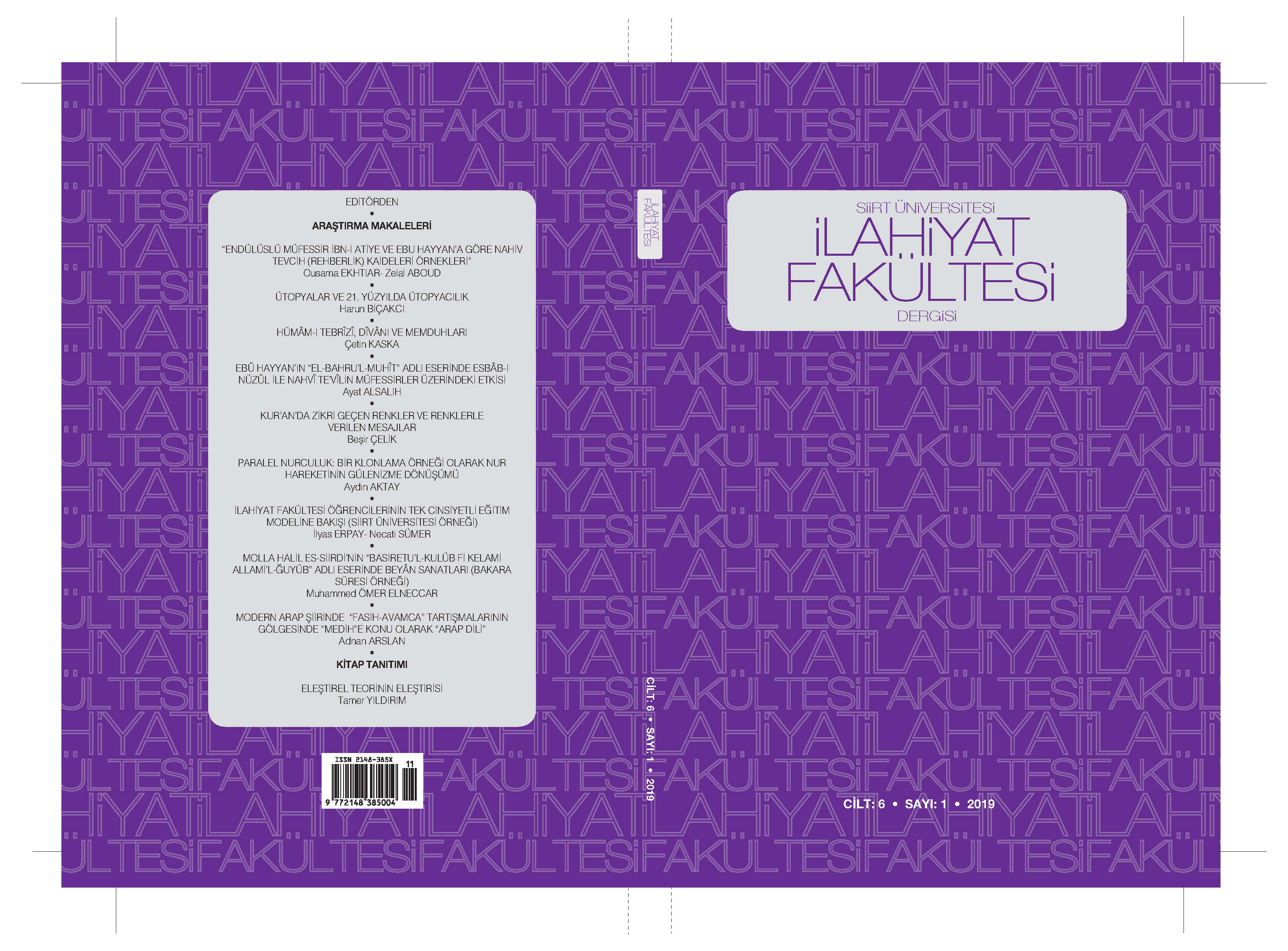Aslam Jankır'ın "Ahlam fi'l-Bahr (Denizdeki Düşler)" Adlı Romanındaki Mekan Olgusu
Bu araştırma, İslam Reşit Çankır'ın ilk romanı kabul edilen "Denizdeki Düşler" adlı romandaki "mekan" olgusunu incelemektedir. İnceleme, "mekan" olgusuna yönelmiş ve pek çok teknik nedenden ötürü bu konuyu seçmiştir. Çünkü romanda, çok sayıda ve birbirinden uzak mekanlar yer almakta ve "mekan" olgusu eserde geçen olaylara baskın çıkmaktadır. Yazarın mekana önem vermesi, eserin "Denizdeki Düşler" şeklindeki başlığı ile temsil edilen metniyle ilk aşamadan itibaren açıkça göze çarpmaktadır. Başlığın semiyotiği (göstergebilimi), Suriyeli bir ailenin dramının geçtiği mekana (denize) girme merakı uyandırmaktadır. O, İstanbul sahilinde zarif elbiseleriyle boğulmuş bir halde bulunarak gündem olmuş çocuğun ailesidir. Romandaki olaylar, metnin yapısı ile kaynaşmış ve güncel olması itibariyle de üretken bir surette pek çok yerle/mekanla bağlantılıdır: Köy-vatan-iki komşu ülkeyi ayıran sınırlar-Mardin-İstanbul-deniz-deniz ötesi ülkeler. "Gerçek" ve "hayal", bu yapı dahilinde iç içe geçmiştir. Çünkü yazar, metnindeki ana unsuru değiştirmiş ve okuyucuyu heyecanlandıran, titreten ve onu olayın içine sürükleyen yeni bir konu işleme arzusuyla onu hayalin emrine vermiştir. Yazar böylece, metni için bir tat ve güzellik yaratmıştır. Bu araştırmanın analizleri, analistik tanımsal yöntemin mekaniği ile uyumlu olup, durumun gerektirdiği ölçüde semiyotikle (göstergebilimle) kesişmektedir. Bu incelemenin bölümlerini, romandaki ana mekanlara göre kısımlara ayırdım ve onu, başlığı inceleyerek başlayıp, ulaştığım en bariz sonuçları zikrederek tamamladım.
Anahtar Kelimeler:
Arap edebiyatı, roman, Aslam Jankır, mekan/yer, Denizdeki Düşler
The Space Phenomenon in Islam Jankır's Novel "Ahlam fi'l-Bahr (Dreams in the Sea)"
This research examines the space phenomenon in the novel "Dreams in the Sea", which is accepted as the first novel of Aslam Reşit Jankır. The study has focused on the phenomenon of "space" and has chosen this topic for many technical reasons. Because there are many and far places in the novel, and the phenomenon of "space" dominates the events in the work. The author's emphasis on space is clearly evident from the first stage, with the text of the work represented by the title "Dreams in the Sea". The semiotics of the title arouses the curiosity of entering the place (sea) where the drama of a Syrian family takes place. She is the family of the boy who became the subject of the agenda by being found drowned in his elegant dresses on the Istanbul coast. The events in the novel are productively linked to many places as they are fused with the structure of the text and are up-to-date: Village-homeland-the borders separating two neighboring countries-Mardin-Istanbul-sea-overseas countries."Real" and "imagination" are intertwined within this structure. Because the author has changed the main element in his text and has given it to the imagination with the desire to work on a new subject that excites and trembles the reader and drags them into the event. The author thus created a flavor and beauty for his text. The analyzes of this research are compatible with the mechanics of the analytical descriptive method and intersect with semiotics to the extent required by the situation. I have divided the chapters of this review into sections according to the main locations in the novel, and I have concluded it by examining the title and citing the most obvious conclusions I have reached.
Keywords:
Arabic literature, novel, Aslam Jankır, place, Dreams at Sea,
___
- Âbâdî, Mahbûba Muhammedî Muhammed. Cemâliyyâtu’l-Mekên fî Kısasi Saîd Hûrâniyye. Dımaşk: Vizêratu’s-Sekâfeti’l-Hey’eti’l- ‘Âmmeti’s-Sûriyye li’l-Kuttâb, 2011.
- Jânkîr, Aslam. Rivêyetu’l-Ehlâm fi’l-Bahr. Türkiye: Şürufât li’n-Neşri ve’d-Dirâsêt, 1. Baskı, 2021.
- Hüseyin, Hâlid. Şi‘riyyetü’l-Mekên fi’r-Rivêyeti’l-Cedîd. Riyad: Müessesetu’l-Yemâmeti’s-Sahafiyye, 1. Baskı, 2000.
- Râşid, İyâs Gālip. “El-Mekên fî Kısasi Mustafa Tacuddin Musa”. el- Mü’temeru’d-Düvel’s-Sânî li’l-Lüġât. Osmaniye: Câmiatu Korkût, Aybel Yayıncılık, 2020.
- Zeytûnî, Latîf. Muʽcemu’l-Mustalahât-Nakdu’r-Rivâye. Lübnân: Mektebetu Lübnân Nâşirûn, 1. Baskı. 2002.
- Şâmî, Ali. el-Felsefetü ve’l-İnsân. Beyrût: Dâru’l-İnsâniyye, 1. Baskı, 1991.
- Tullâb, Ruzeyka – Kasî, Sabîra. el-Meken fî Rivâyeti “Nisâ’ Kazanova” li Vâsîynî el-Aʽrac- el- Binye va’l-Vazîfe. el-Cumhûriyyatu’l-Cezâiriyyetu’d-Demoktrâtiyyetu’ş-Şaʽbiyye: Câmiatu Buveyra, Risâletu Mâcistir, 2017-2018.
- Bûʽazza, Muhammed, Tahlîlu’n-Nassı’s-Serdî Takniyyât ve’l-Mefêhim. Cezâyir: Menşûrâtu’l-İḫtilêf, 1. Baskı, 2010.
- Kâsım, Sîzâ. Binâu’r-Rivâyêt Dirâse Mukârane fi Sülâsiyyeti Necîb Mahfûz. Kâhire: Mektebetu’l-Üsra, 1978.
- Murtâd, Abdülmelik. “Fî Nazriyyeti’r-Rivâye-Bahsun fî Takniyyâti’s-Serd” el-Meclisu’l-Vatanî li’s-Sekâfe ve’I-Fünûn ve’l-Êdêp. Kuveyt ,1998.
- İbn Manzûr, Ebü’l-Fazl Cemâlüddîn Muhammed. Lisânü’l-ʿArab. Beyrut: Dâru’s-Sâdır, 4. Baskı, 2005.
- ISSN: 2757-752X
- Yayın Aralığı: Yılda 2 Sayı
- Başlangıç: 2014
- Yayıncı: Siirt Üniversitesi İlahiyat Fakültesi
Sayıdaki Diğer Makaleler
Georg Simmel’ın Din Teorisinin Temel Yaklaşımları
SOSYO POLİTİK ETKİLER BAĞLAMDA ORTAYA ÇIKAN İMAM HATİP KUŞAKLARI ÜZERİNE BİR DEĞERLENDİRME
Vahid Paşa Yazma Eser Kütüphanesi’ndeki Fatih Devri Ciltleri
Aslam Jankır'ın "Ahlam fi'l-Bahr (Denizdeki Düşler)" Adlı Romanındaki Mekan Olgusu
Te’vîlâtü’l-Kur’ân ve Tefsîru’l-Menâr’ın “Akletmez misiniz” Ayetleri Bağlamında Karşılaştırılması
HZ. MUHAMMED’İN NÜBÜVVETİNİN İSPATI BAĞLAMINDA ZEMAHŞERÎ’NİN İ’CÂZÜ’L-KUR’ÂN ANLAYIŞI
İslâm Hukukunun Erken Döneminde Ceza Yargılamasında Alenilik
Ahmed Mahmûd Subhî’nin Hayatı, Eserleri ve İslam Düşüncesine Katkısı
